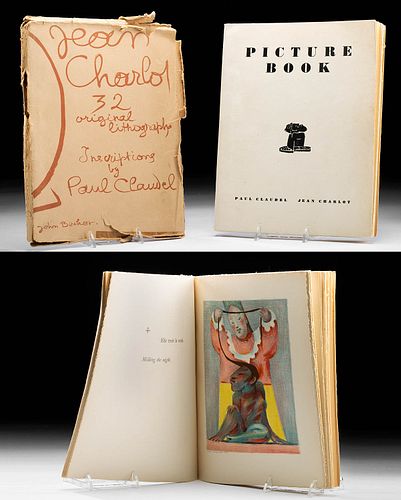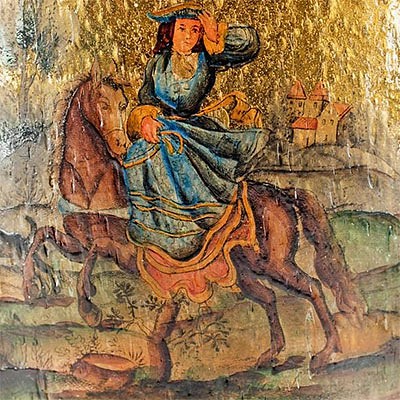Signed Jean Charlot "Picture Book" w/ Dust Cover, 1933
Lot 34a
About Seller
Artemis Fine Arts
686 S Taylor Ave, Ste 106
Louisville, CO 80027
United States
Selling antiquities, ancient and ethnographic art online since 1993, Artemis Gallery specializes in Classical Antiquities (Egyptian, Greek, Roman, Near Eastern), Asian, Pre-Columbian, African / Tribal / Oceanographic art. Our extensive inventory includes pottery, stone, metal, wood, glass and textil...Read more
Categories
Estimate:
$5,000 - $8,000
Absentee vs Live bid
Two ways to bid:
- Leave a max absentee bid and the platform will bid on your behalf up to your maximum bid during the live auction.
- Bid live during the auction and your bids will be submitted real-time to the auctioneer.
Bid Increments
| Price | Bid Increment |
|---|---|
| $0 | $25 |
| $300 | $50 |
| $1,000 | $100 |
| $2,000 | $250 |
| $5,000 | $500 |
| $10,000 | $1,000 |
| $20,000 | $2,500 |
| $50,000 | $5,000 |
| $100,000 | $10,000 |
| $200,000 | $20,000 |
About Auction
By Artemis Fine Arts
May 13, 2021
Set Reminder
2021-05-13 12:00:00
2021-05-13 12:00:00
America/New_York
Bidsquare
Bidsquare : Spring Art Auction | Fine, Folk, Fun
https://www.bidsquare.com/auctions/artemis-gallery/spring-art-auction-fine-folk-fun-6949
Featuring visual treats from around the world, and back in time to present day - fine art, folk art, and fun artsy objects. Paintings. Sculptures. Textiles. More. Convenient in-house shipping. Artemis Fine Arts info@artemisgallery.com
Featuring visual treats from around the world, and back in time to present day - fine art, folk art, and fun artsy objects. Paintings. Sculptures. Textiles. More. Convenient in-house shipping. Artemis Fine Arts info@artemisgallery.com
- Lot Description
Jean Charlot (also Louis Henri Jean Charlot, French, naturalized American, active in Mexico, 1898-1979). "Picture Book" - signed in ink by artist Jean Charlot, typesetter/printer Lynton R. Kistler, and designer Merle Armitage - and numbered 158. includes 32 original color lithographs, inscriptions by Paul Claudel translated into English by Elise Cavanna. New York: John Becker, 1933. First edition. Limited to 500 signed first edition copies. Quarto. 128 pages. Includes 32 original color lithographs the plates by Charlot - several leaves are unopened. Also includes original dust cover. Size: 11" L x 8.625" W (27.9 cm x 21.9 cm)
Charlot's inspiration for "Picture Book" was art for the people in the tradition of the Imagerie d'Epinal (1888), a collection of broadsheets by various French artists, each one telling a different fairy tale with accompanying text. In addition, he hoped that the book would carry on the Medieval and Renaissance traditions of the artist's studio source book. Hence, Picture Book includes a vast repertoire of the themes Charlot had addressed in his oeuvre up to that point in his career.
Born in Paris to a Russian emigre father and a mother whose family originated in Mexico City, with a grandfather who was French-Indian mestizo, Charlot moved to Mexico City in 1920 when his mother returned. Joining Diego Rivera and Jose Clemente Orozco, Charlot painted frescoes for the Mexican government during the rise of the Mexican Modernist mural movement. In addition, he was hired as a staff artist for a Carnegie Institute archaeological expedition in the Yucatan. In 1929, Charlot moved to the United States, as was popular with many of the Mexican Modernists, and taught at various institutions: the Art Students League in New York City, the Colorado Springs Fine Art Center, the University of Georgia, and the University of Hawaii.
According to the Rollins Cornell Fine Arts Museum, "Over his long and productive career Jean Charlot had a profound influence on printmaking and mural painting in both Mexico and the United States. He was born in Paris and in 1921 moved to Mexico City after the death of his father—his mother was of mixed French and Aztec ancestry, a fact in which the family took great pride. He arrived at an auspicious time in Mexican history, as the period of unrest and social change surrounding the Mexican Revolution was beginning to wind down. When he arrived, he joined a ferment of artistic and cultural experimentation—known as Mexican modernism—that was answering the urgent question of what it meant to be Mexican. Charlot, who brought with him printmaking knowledge and equipment, as well as examples of modernist prints from France, is often credited with helping to inspire a revolution in printmaking in Mexico.
Charlot joined SOPTE (Sindicato de los Obreros Técnicos, Pintores y Excultores), an artist’s union, and signed on to their 1922 “Declaration of Social, Political, and Aesthetic Principles,” written by David Alfaro Siqueiros, whose large fresco murals are icons of Mexican Modernism. In the Declaration, the artists condemned easel painting as overly aristocratic and intellectual, preferring instead the more direct and accessible mediums of murals and printmaking. Charlot also joined the movement of artists and intellectuals known as Stridentism. Influced by Italian Futurism, Spanish Ultraism, and Dada, Stridentism celebrated modern technology and artistic forms, rejecting the staid classicism of traditional European art. Unlike the Futurists, however, the Stridentists rejected war and fascism, maintaining their socialist political commitments.
Charlot moved to New York in 1929, spending time there with George C. Miller, the best fine art lithographer in the United States, to whom he was introduced by José Clemente Orozco, another of his colleagues in the Mexican modernist movement. In 1949 he went to Honolulu to do a mural commission for the University of Hawai’i. He so enjoyed his time there that he stayed until his death in 1979, executing many of his prints by correspondence with Lynton R. Kistler, a master lithographer based in Los Angeles.
Provenance: ex-private Moore collection, Denver, Colorado, USA, acquired prior to 1990
All items legal to buy/sell under U.S. Statute covering cultural patrimony Code 2600, CHAPTER 14, and are guaranteed to be as described or your money back.
A Certificate of Authenticity will accompany all winning bids.
We ship worldwide and handle all shipping in-house for your convenience.
#162394Signed in ink by artist Jean Charlot, typesetter/printer Lynton R. Kistler, and designer Merle Armitage - and numbered 158. A few minute stains to the cover, but very minor. Comes with original dust cover that has some tears, losses, and tape marks. Otherwise, the book is still bound in its original paper binding, with many of the leaves unopened, and appears to be in overall excellent condition.Condition
- Shipping Info
-
All shipping is handled in-house for your convenience. Your invoice from Artemis Gallery will include shipping calculation instructions. If in doubt, please inquire BEFORE bidding for estimated shipping costs for individual items.
-
- Buyer's Premium



 EUR
EUR CAD
CAD AUD
AUD GBP
GBP MXN
MXN HKD
HKD CNY
CNY MYR
MYR SEK
SEK SGD
SGD CHF
CHF THB
THB















